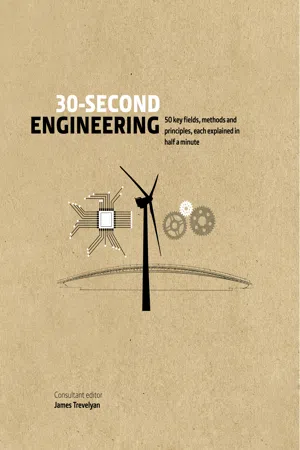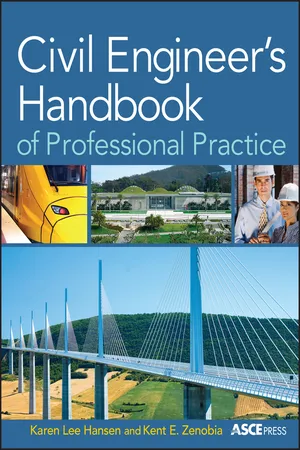Civil Engineering
Civil engineering is a branch of engineering that focuses on the design, construction, and maintenance of infrastructure such as buildings, roads, bridges, and water supply systems. Civil engineers apply scientific and mathematical principles to develop practical solutions for society's infrastructure needs. This field plays a crucial role in shaping the built environment and improving quality of life.
4 Key excerpts on "Civil Engineering"
- eBook - ePub
- P.K. Jayasree, K Balan, V Rani(Authors)
- 2021(Publication Date)
- CRC Press(Publisher)
...Civil Engineering is an extensive profession, and it includes many different specialized subfields like structures, geology, hydrology, soils, geography, environment, material science, mechanics, and others. 1.4 Branches of Civil Engineering Civil Engineering is considered to be ancient and looked upon as mostly traditional and unchanging. However, challenges of people’s life and works demand that Civil Engineering should go in tune with these changes and modern needs. It basically deals with various types of construction works like buildings, foundations, roads, hydraulic structures, etc., which involves the operation of planning, analysis and design, execution, and finally maintenance. Civil Engineering extends through many disciplines which are dependent and interact with each other. The branches of Civil Engineering are illustrated in Figure 1.2 and are explained in detail as follows. FIGURE 1.2 Branches of Civil Engineering. 1.4.1 Structural Engineering Structural engineering is the branch of Civil Engineering which involves structural design using perfect structural analysis by calculating stresses in structural components, considering the behavior of concrete and loads according to the type of structure. This branch of engineering includes the study of the following: Design of Reinforced Cement Concrete (RCC) structures like multistoried buildings, retaining walls, water tanks, bridges, tunnels, public buildings, residential buildings, etc. Design of steel structures like railway platform, factory sheds, steel bridges, etc. Design of earthquake-resistant structures. 1.4.2 Building Construction This discipline includes the construction of different structures, the different types of buildings, various building components like foundations, brickwork, doors and windows, RCC work for beams, slabs, columns, lintels, floors, roofs, etc...
- eBook - ePub
30-Second Engineering
50 key fields, methods, and principles, each explained in half a minute
- James Trevelyan(Author)
- 2019(Publication Date)
- Ivy Press(Publisher)
...The Industrial Revolution reduced the cost of iron and steel in the nineteenth century and Thomas Telford showed how it could be used for bridges, canals and harbours. Together with Isambard Kingdom Brunel’s railways, bridges and ships, these developments transformed transport. Today, civil engineers are working to solve challenges and improve people’s lives – from creating flood defences and dams to building our largest infrastructures and tallest buildings. Every project poses challenges: there may be obstructions in the ground or poor soil conditions; tunnels or structures that the new construction needs to weave through; or constraints on finance and time. Engineers think creatively to work through these problems, try different solutions and choose the best option. Finding creative economic solutions for difficult construction challenges is immensely rewarding, and civil engineers embrace new technologies to create a world that can support future generations. 3-SECOND CORE Civil Engineering enables buildings, roads, bridges and all the other structures in our built environment, ensuring that they are safe and durable enough to last for centuries. 3-MINUTE IDEA Structural engineering, a part of Civil Engineering, is about ensuring that buildings, dams and bridges stand up. Calculations based on maths and physics principles predict how structures respond to the forces that nature throws at them – gravity, wind and earthquakes. Equally important, structural engineers predict forces during construction. That’s why homes, schools and offices are safe to live in...
- Karen Hansen, Kent Zenobia(Authors)
- 2011(Publication Date)
- Wiley(Publisher)
...Civil engineers often cite the standard specifications of the city, county, or state in which the project is located, particularly in the design of off-site improvements. These specifications are frequently tried-and-true specifications that are developed by the state departments of transportation (which invest considerable funding in research) and are often wholly adopted by public works departments at the local level. Structural engineers specialize in the design of foundations (piles, caissons), substructures (habitable portions of a structure that are below ground, such as basements), and superstructures (the portion of the project above grade, or above the water in the cases of bridges built across bays, lakes, and rivers). Like civil engineers, structural engineers are licensed by the state in which they do business, but they are frequently required to have specialized education and training beyond that of a civil engineer. Structural engineers—frequently hired by architectural firms for their expertise—are focused on the performance of the structural system under various loading conditions that fall into two classifications: static and dynamic loading. Static loading comprises dead loads (gravitationally imposed loads resulting from the weight of the structure and its permanent equipment) and live loads (mobile loads that are not necessarily present at all times). Furniture, snow, hydrostatic pressure (the pressure at any point exerted on a surface by a liquid at rest), and a building's occupants are examples of live loads. Dynamic loads, such as seismic activity and wind can occur suddenly, and vary in intensity, duration, and location. Structural engineers are responsible for protecting the lives and property of project users in a cost-effective way...
- Rodrigo Salgado(Author)
- 2022(Publication Date)
- CRC Press(Publisher)
...The discussion is pursued in the context of the “global economy,” which to a considerable extent has become a reality. In the paradigm of the global economy, barriers to trade, including engineering services, weaken considerably, forcing the engineer to deal with technical, cultural, legal, and language issues that could be safely ignored in the past. This chapter concludes with a discussion of units, which are needed in any engineering calculation. 1.1 The geotechnical engineering industry 1.1.1 Geotechnical engineering, foundation engineering, and geotechnical and foundation engineering problems Engineering is the creative use of experience, empirical methods, and engineering science to solve engineering problems. Engineering involves the search for solutions to problems that require significant technical and scientific knowledge and that change the environment in some way or make new things possible. For example, a civil engineer may be interested in connecting one bank of a river to the other, while a chemical engineer may be interested in the manufacturing of a certain chemical in industrial scale. An engineering problem is subjected to a number of constraints arising mainly due to economic and environmental reasons. More formally, an engineering problem may be defined in a general way as the need or wish to change something from a current state A to a new state B in the most economical fashion, under safe conditions, with minimum or no harm to the environment. Additional requirements arising out of legal and aesthetic issues also need to be fulfilled. Fortunately, there are also a number of tools available to the engineer that facilitate achieving an optimal design solution: engineering science, empirical rules, and experimental techniques. Geotechnical engineering is the engineering of problems involving the ground...



